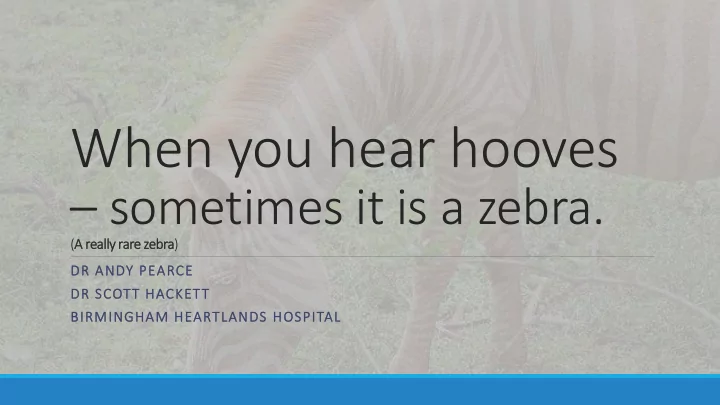

When you hear hooves – sometimes it is a zebra. (A A really rare zebra) DR ANDY PEARCE DR SCOTT HACKETT BIRMINGHAM HEARTLANDS HOSPITAL
The Case 15 month old male. At presentation: Cough – 5 month history. Discharge from left ear – 2 separate occasions. Diarrhoea – Loose stools 4-5x/day. Past Medical History: ◦ Rhinitis. ◦ Growing well. ◦ Not meeting all development milestones. ◦ Up to date with immunisations . ◦ No known TB contacts. Examination ◦ Coarse crepitations bilaterally. No clubbing. ◦ Right bulging tympanic membrane. ◦ Otherwise normal examination.
Question 1: What do you think the most likely diagnosis is at this stage? HIV. Primary immunodeficiency. PCD. Cystic Fibrosis.
Family History First cousins Primary Ciliary Dyskinesia 5 month old well Well. brother
Questions 2: Bearing in mind the family history, what is the probability of this child having PCD? 25% 12.5% 6.25% 3.125%
Investigations FBC and WCC differential, Immunoglobulins (GAM + Functional), Sweat Test, Ciliary Brushings all normal. Microbiology at presentation: ◦ Viral throat swab – Adenovirus +ve on PCR. ◦ Right ear swab culture H.Influenzae . ◦ Sputum – Upper respiratory tract flora. Gastric washings did not grow M.Tuberculosis. Total Lymphocytes 2749 cells/uL Percent CD3 cells 38 % %CD3+ TCR a/b+ve 0% Lymph CD3+ cells 1037 cells/uL TCR a/b+ CD4/8-ve 0% Percent CD4 cells 9 % %CD3+ TCR g/d +ve 22% Lymph CD3+4+ cells 240 cells/uL TCR g/d+ CD4/8-ve 15% Percent CD8 cells 6 % Lymph CD3+8+ cells 175 cells/uL
Question 3: Considering the T-Cell subset analysis, what is the problem? An absent population of TCR a/b +ve CD3+ cells. Low population of CD4 and CD8 cells. A population of CD3+ cells which are expressing neither CD4 or CD8. All of the above
Diagnosis and management TCR alpha sub-unit deficiency. ◦ Genetically confirmed. ◦ 2 other families with 2 other patients in the literature. ◦ Chromosomal region 14q11.2. ◦ Homozygous G to A substitution affecting the TCR-Alpha subunit constant gene (TRAC). Initially managed with antimicrobial prophylaxis and fortnightly Cuvitru 2g. ◦ MDT approach Currently awaiting bone marrow transplant but…: ◦ Lung lesion – EBV lymphoproliferative disease . ◦ High EBV load, requiring Rituximab.
Learning points Consider primary immunodeficiency even if there seems to be another, more obvious, diagnosis. Not to be fooled when a child is growing is well. Family history – Important, but: ◦ Important not to rule out other conditions. ◦ Is it feasible to have found the second-cousin with the same diagnosis? ◦ Also difficult to establish with large, consanguineous families. Trust the radiographer’s instincts!
Question 4 Why is this disease not always severe early on when this affects the major T-Cell receptor? I have no idea. I have a theory but I’m not willing to discuss it. I have a theory and want to discuss in a minute. I don’t really care!
Recommend
More recommend